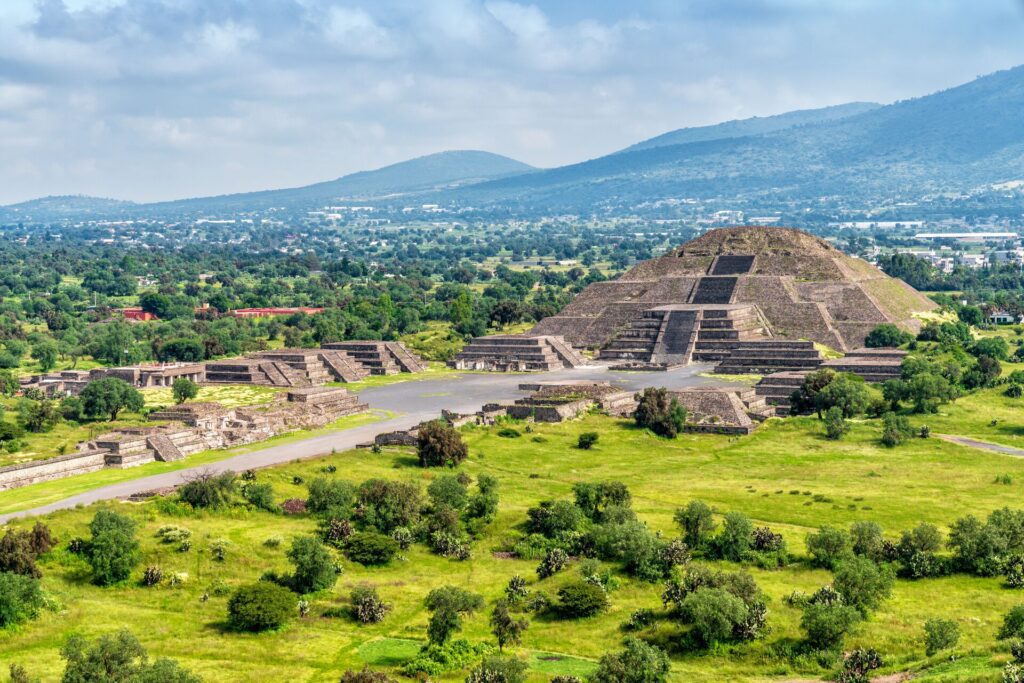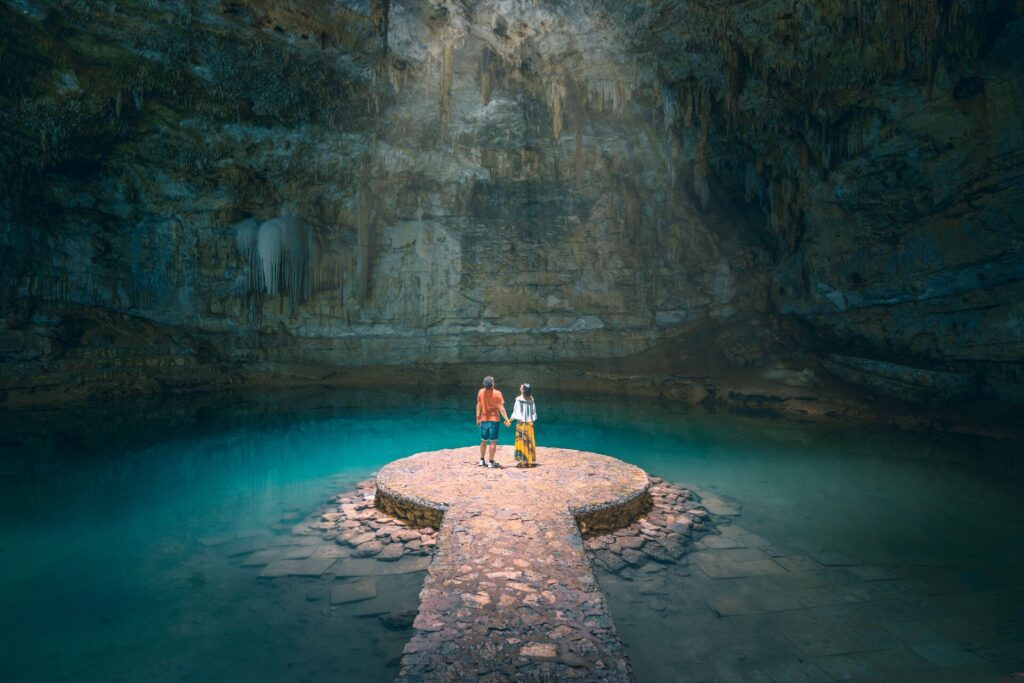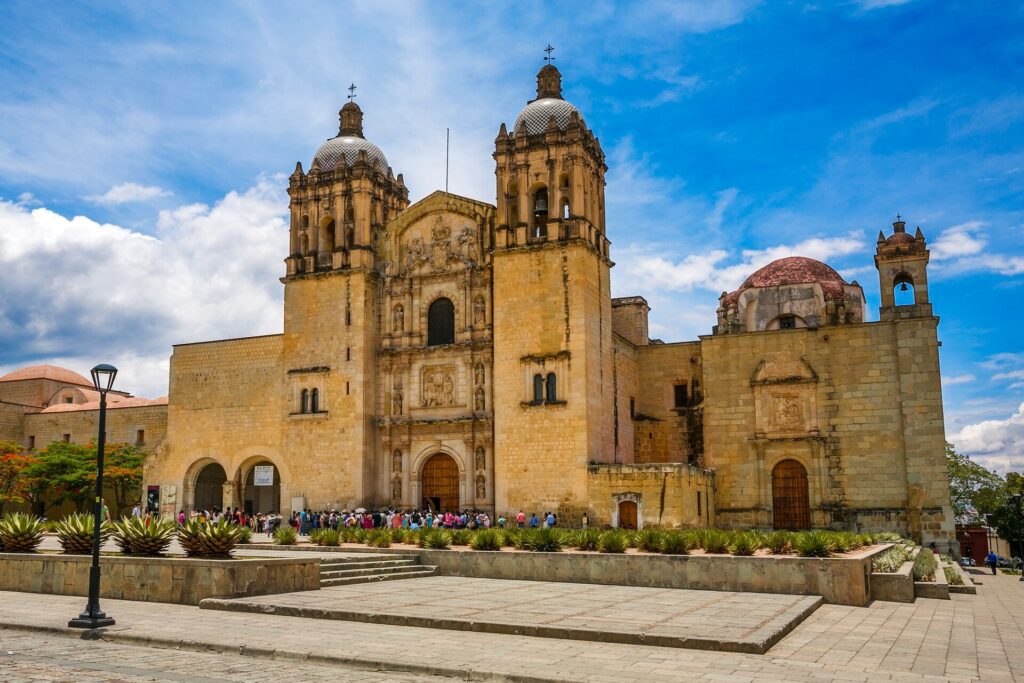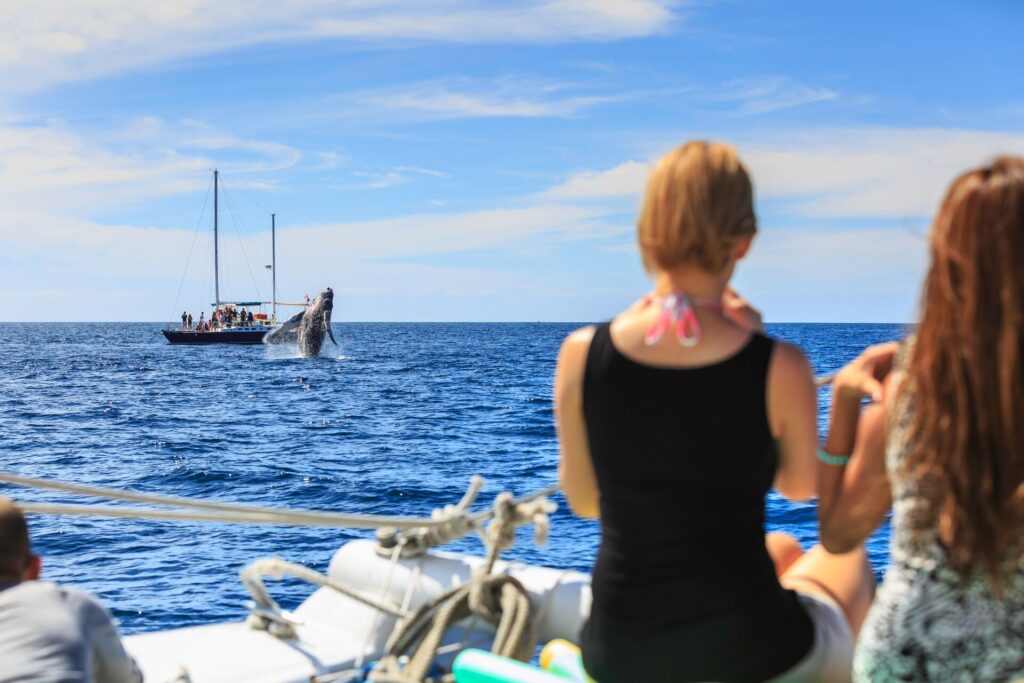Recently updated on July 9th, 2025 at 04:18 am
Bordered by the United States, Guatemala and Belize, and flanked by the Pacific Ocean, Gulf of Mexico and Caribbean Sea, Mexico is a country of great contrasts – as you’ll see on this handy map. On a cultural level, it’s home to more than 129 million people, including Indigenous nations such as the Nahua, Maya, Zapotec, Mixtec and Otomí, with 68 officially recognised national languages. It all adds up to a national tapestry that’s both intricate and welcoming, visible in everything from the architecture to the cuisine in legendary cultural hubs like Mexico City, Guadalajara, Monterrey, Mérida, Oaxaca and beyond. Plus, with 35 UNESCO World Heritage-listed sites, more than any other country in the Americas, its treasure trove of wonders spans everything from jungle-fringed pyramids and fossil-studded deserts to colonial cities and marine reserves. So, wherever you follow your curiosity – whether it’s to the ancient sites of Teotihuacan and Chichén Itzá, the beaches of Playa del Carmen or an iconic festival – you’ll find a destination with the scale, soul and variety to surprise you at every turn. Here, your ultimate travel guide to exploring everything Mexico has to offer.


1. Explore Ancient Mayan and Aztec Ruins
Long before the Spanish conquest, Mexico was home to some of the most advanced cultures in the ancient Americas. The Olmec, often considered Mesoamerica’s first great civilisation, flourished along the Gulf Coast from around 1600BC to 400BC. The Maya first emerged around 2000BC, but it was between 250 and 900AD that they built their iconic city-states and pyramids. Then, in the 14th century, the Aztec Empire rose to power before falling to the Spanish in the early 1500s.
On the Yucatán Peninsula, Chichén Itzá is the best-known Mayan site – a UNESCO World Heritage site and one of the New Seven Wonders of the World – with its 30m-high pyramid, El Castillo, famously casting a snake-shaped shadow during the equinoxes. Elsewhere in the region, Uxmal features the unusual Pyramid of the Magician and the ornate stonework of the Nunnery Quadrangle, while Palenque is revered for its 7th century Temple of the Inscriptions and the tomb of King Pakal.
Further afield in the Valley of Mexico, the sprawling city of Teotihuacan was built between 100BC and 550AD and was once home to some 100,000 people. While its original builders remain a mystery, it became one of the most influential cities in pre-Columbian Mesoamerica, with the Pyramid of the Sun, Pyramid of the Moon, and the Avenue of the Dead among its most intriguing relics.
And in modern-day Mexico City, Plaza de las Tres Culturas fuses Aztec ruins, Spanish colonial architecture and modern-day elements into a single, symbolic square, while the Shrine of Our Lady of Guadalupe, built on the site of a former Aztec temple, remains one of the world’s most important Catholic pilgrimage destinations.


2. Relax on Breathtaking Beaches
With two coasts to choose from, you can do as much – or as little – as you like on Mexico’s 11,000km of shoreline: head east and take your pick of protected sandy stretches along the Gulf of Mexico, or go west for the wave-pummelled shores and world-class surf breaks of the Pacific Ocean. On the Yucatán Peninsula, places like Cancún, Playa del Carmen and Tulum are known for their white-sand beaches and clear, quintessentially Caribbean turquoise waters – ideal for swimming, snorkelling and sailing. Over on the Pacific coast, Puerto Vallarta, Sayulita, Mazunte and Puerto Escondid offer golden beaches, consistent surf, and a mix of resort towns and laidback hideaways.
Whichever beach break you choose, the best time for it is during the dry season, from November to April, when skies are clear and humidity is low. But, with winter temperatures averaging 26°C and summer rising to 30°C, you can swim in Mexico all year round – especially as seawater temperatures only dip to 24°C in the cooler months.
Our 10-day Authentic Mexico adventure takes you from Mexico City to Cancun – and to all the most iconic cities, ancient wonders and natural highlights in between.
3. Taste World-Famous Mexican Cuisine
With Indigenous, Spanish, African and Middle Eastern influences layered over thousands of years of cultural traditions, Mexican cuisine is far more complex than the Tex-Mex staples made popular by Taco Tuesdays. Authentic dishes are built on corn, beans, chillies, herbs and time-honoured techniques like nixtamalization (soaking and grinding corn into masa, the soft dough used for tortillas and tamales), slow-cooking meats in underground pits, and crafting mole – layered sauces made from chillies, spices, seeds, nuts and sometimes chocolate – all with ancient Aztec and Mayan roots.
Signature dishes are seasonal and regional. In Oaxaca, you’ll find mole negro, tasajo (thinly sliced grilled beef), chapulines (roasted grasshoppers) and nicuatole, a corn-based cinnamon jelly. In Puebla, don’t miss chiles en nogada or the smoky complexity of mole poblano. The Yucatán is known for cochinita pibil, pork marinated in achiote and slow-roasted in banana leaves, and salbutes, fried tortillas topped with pulled turkey. And in Mexico City, look for tlacoyos, pozole, and tacos al pastor, carved hot from the spit.
Thirsty? Fill your cup with tequila, mezcal, or the beloved champurrado – a moreish hot chocolate drink with a spicy kick. Dining ranges from bustling markets to Michelin-starred restaurants, with the two-starred Quintonil and Pujol leading Mexico City’s fine-dining scene. In between, cantinas are part pub, part restaurant, serving easy bites and live music.
Plus, you can Make Travel Matter with foodie experiences that deepen your culinary immersion. With Adventure World, you’ll taste beyond the burrito on guided gastronomy excursions in Mexico City, sampling street food at Market San Juan and sipping traditional drinks at Bar La Opera. In Oaxaca, you can meet the cooks and culinary creatives at the Benito Juárez and 20 de Noviembre markets before wetting your whistle at an authentic mezcal tasting.
Take part in authentic Oaxacan cooking classes, explore Mayan markets with local culinary experts and Make Travel Matter on your Mexico holiday. Chat to our experts on 1300 363 055 (AU) 0800 238 368 (NZ).


4. Discover Stunning Natural Wonders and Cenotes
With 67 national parks and countless ecological reserves dotting the country, you can take your pick of wild terrains for your outdoor adventures, from thirsty plains to tropical rainforests and rumbling volcanoes. In Chihuahua’s Sierra Madre Occidental Range, the Copper Canyon is four times larger than the Grand Canyon, setting the scene for 4WD adventures and the legendary El Chepe train journey. You can also visit Cumbres de Monterrey National Park for spectacular mountain trails, or hike Pico de Orizaba, Mexico’s tallest mountain at 5,636 metres.
Keen to dive into a new thrill? In the south near Palenque, the Lacandon Jungle fringes the vivid blue Agua Azul waterfall, while in Chiapas, you can explore the towering cliffs of Sumidero Canyon by boat on the Grijalva River. And Quintana Roo’s sparkling Bacalar Lagoon is also a photogenic spot to cool off, with the ‘Lake of Seven Colours’ offering idyllic conditions for both kayaking and filling your camera’s memory card.
Mexico is also home to over 6,000 cenotes – freshwater sinkholes naturally formed by collapsed limestone. And their allure goes beyond natural beauty: the Maya viewed them as sacred portals to the underworld, and many still house relics from ritual offerings, including ceramics and even human remains. Sambulá, near Mérida, is known for its dramatic caverns and crystal-clear waters, while the cenotes of Río Secreto, near Playa del Carmen, offer guided swims and walks through flooded caves filled with stalactites.


5. Dive Into Rich History and Cultural Heritage
Along with its famous archaeological sites, Mexico’s vibrant heritage lives in everything from its preserved towns to its buzzing markets. In Chiapas’ San Cristóbal de las Casas, colonial architecture and Indigenous cultures converge: its 16th century Templo de Santo Domingo is an ornate example of Baroque style, while the neighbouring craft market is a hub for locally made textiles, amber jewellery and authentic handicrafts from nearby Tzotzil Maya villages such as San Juan Chamula and Zinacantán. On the Yucatán Peninsula, Mérida was founded over 450 years ago atop the ancient Maya city of T’ho and its cathedral, completed in 1598, is the oldest in Latin America. Take a stroll along its Paseo de Montejo – modelled after Paris’s Champs-Élysées – and through the Mayan World Museum of Mérida, where you can explore the region’s pre-Hispanic roots in a collection of more than 1,160 exhibits.
And further west, the UNESCO-listed city of Campeche is well worth a scenic detour. Once a key port, its pastel-coloured Historic Centre is encased by fortified stone walls, first built in 1686. Spanish colonists once lived inside them, while Maya communities thrived in the surrounding neighbourhoods. Highlights here include the bastions of San Carlos and La Soledad, the Ex-Templo de San José, and the Campeche Archaeological Museum, which showcases the twists and turns of Mexico’s ever-unfolding cultural story.
Discover Mexico’s fascinating past and vibrant present on our 10-day Classic Mexico holiday, exploring iconic ruins, natural wonders and vibrant cities rich in food, art and history.
6. Experience Vibrant Cities Like Mexico City and Puebla
Ancient history and modern innovation unfurl side by side in Mexico’s urban hubs. Today the capital, Mexico City – the Western Hemisphere’s oldest urban settlement, which was once the Aztec metropolis of Tenochtitlan – is a great place to uncover its archaeological treasures as well as its present-day character. Start at the Zócalo, one of the world’s largest public squares, framed by both Latin America’s largest Cathedral and the Aztec ruins of Templo Mayor. A wander along Madero Street unveils more layers: the Temple of San Francisco, the tiled façade of Casa de los Azulejos, the gleaming Palacio Postal, and the art deco splendour of the Palacio de Bellas Artes. For cutting-edge contemporary art, head to Museo Jumex or the Soumaya Museum, prized for its striking modernist design, extensive collection of Old European and 19th century masters, and commitment to women artists.
Just 130km southeast, Puebla is a World Heritage-listed city recognised for its impressive Renaissance, Baroque and Neoclassical architecture, founded in 1531. A visit to its Historic Centre is a chance to see more than 2,600 monuments, including the Cathedral of Puebla with its twin bell towers and the extravagantly tiled Capilla del Rosario. Other key cities worth exploring include Oaxaca, Guadalajara, Mérida, San Luis Potosí, Monterrey and San Miguel de Allende.


8. Enjoy Thrilling Outdoor Adventures and Marine Life
Mexico’s wide variety of terrains ensures there’s an outdoor activity to suit every type of adventurer. If you’re ready to stretch your legs, lace up your boots for a trek into the Copper Canyon, where routes into Urique descend deep into one of the world’s largest canyon systems. Or explore the 100km Sierra Norte de Oaxaca network, where trails weave through pine forests, remote Zapotec villages and dramatic ridgelines. Into rock climbing? In Nuevo León, El Potrero Chico’s towering limestone cliffs are renowned for their world-class multi-pitch routes. Or take your thrills underground in Guerrero, where the Grutas de Cacahuamilpa cave system – one of the world’s largest – features cathedral-like caverns and extensive guided routes.
If you prefer your adrenaline with a splash of H₂O, head to the freshwater playgrounds of Huasteca Potosina for canyoning tours, or strap on your fins and snorkel along the coast. The Mesoamerican Barrier Reef is second only to the Great Barrier Reef in size and is home to more than 500 species of reef fish and 60 types of coral. Dive into it at the UNESCO-listed Sian Ka’an Biosphere Reserve or at Cozumel’s Palancar Reef, where you can spot sea turtles, rays and vibrant coral gardens. Plus, between December and April, whale-watching is at its peak in Baja California, when grey, humpback and blue whales pass close to shore on their annual migration.


9. Stay in Beautiful Boutique Hotels and Eco Resorts
Mexico’s accommodations are as immersive as their settings – from boutique hotels in restored colonial buildings to off-grid lodges tucked deep in volcanic valleys. In the cities, staying in the thick of the action brings a deeper appreciation of their cultural layers. Mexico City’s plush Casa de la Luz Boutique Hotel, for example, blends heritage architecture with contemporary luxury in the heart of the Historic Centre. In Oaxaca, Hotel Casa Santo Origen offers a peaceful rural setting mere minutes from the city’s buzzing food, craft and festival scene. And over in Mérida, the leafy Treehouse Boutique Hotel is a green oasis in Santa Ana, a character-filled neighbourhood known for its weekend markets and colourful buildings.
Beyond the cities, Mexico’s interior highlands, deserts and jungles offer meaningful stays close to nature. Set your sights on Chiapas, the Sierra Norte of Oaxaca, Pico de Orizaba, or Copper Canyon, where ecolodges tread lightly and have easy access to wilderness areas and remote Indigenous communities.
On the coast, Baja California Sur, the Riviera Nayarit, and the Yucatán Peninsula boast a host of eco-conscious beachfront resorts and boutique hotels rooted in their natural surroundings. And Mexico also has more than 100 islands scattered along both the Pacific and Caribbean coasts, many protected as biosphere reserves or national parks. On remote Holbox Island, the Casa Las Tortugas boutique stay offers just the right balance of laid-back island time, untouched tropical beauty and barefoot adventuring. With so much variety across the country, it’s worth combining a range of accommodation styles to level up your experience – chat to Adventure World’s Destination Experts on 1300 363 055 (AU) 0800 238 368 (NZ) to create your ultimate accommodation hitlist.
10. Meet the Warm and Welcoming People of Mexico
With more than 60 Indigenous nations – including the Nahua, Maya, Zapotec, Mixtec, and Otomí peoples – alongside communities of Spanish, Afro-Mexican, Lebanese, German, and Chinese descent, Mexico has a way of making everyone feel welcome.
Beyond meeting locals at markets or during festivals and other celebrations, community-run cooking classes, Indigenous-led cultural experiences, and visits to smaller towns and villages are all excellent ways to Make Travel Matter and connect authentically with the culture. For example, in Teotitlán del Valle (near Oaxaca), Zapotec families are known for welcoming visitors into their homes to demonstrate traditional weaving techniques using natural dyes – often accompanied by a hearty home-cooked meal. In Chiapas, the Tzotzil and Tzeltal Maya villages maintain a long-standing tradition of intercultural exchange, sharing their arts and crafts through locally run cooperatives and community tourism initiatives.
Wherever you venture, be sure to show your appreciation: tipping is customary across Mexico, with 10 to 15 percent the norm in restaurants.
